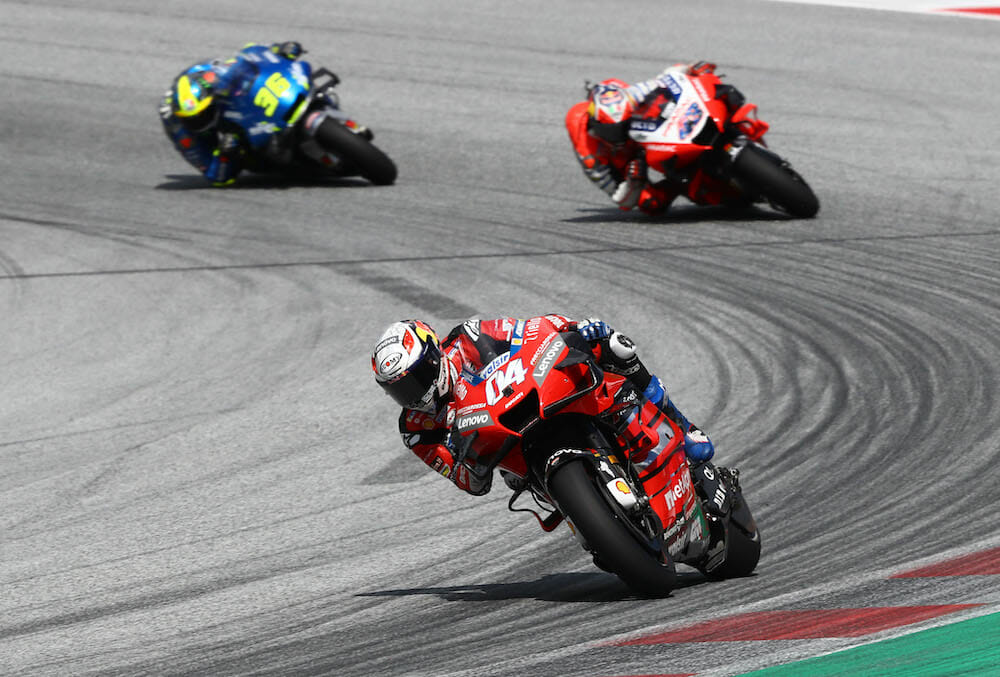Michael Scott | August 26, 2020
Cycle News In The Paddock
COLUMN
Tunnel Vision And The Racers’ View
The sight of Dovi, Mir and Miller on the Red Bull Ring podium being “protected” from the prize-givers after the first of two races in Austria with careful don’t-touch-me congratulations and conscientious social distancing was one of the more bizarre moments of a bizarre weekend.
It was the climax of a day of maximum scares and whisker-close escapes from ghastly accidents—bikes and bodies flying through the air, missing each other by millimeters. But hey, let’s don’t take any unnecessary risks here, guys.
 Andrea Dovizioso leads Jack Miller and Joan Mir in the 2020 Austrian MotoGP .
Andrea Dovizioso leads Jack Miller and Joan Mir in the 2020 Austrian MotoGP .
The first of two GPs at the speedy but simplistic Austrian circuit illustrated with frightening clarity the random nature of racing danger. It started in Moto2, when Bastianini fell off near the front, leaving his bike spinning mid-track just over a blind rise. There were many miraculous misses for those following, and only one terrifying hit. It took 30 minutes of scary tension to clear up the mess, and almost as long before it became clear that the misfortunate rider Hafizh Syahrin had escaped serious injury.
This was just the curtain-raiser. The subsequent MotoGP race was just eight (out of 28) laps old when an even more horrifying scenario unfolded—one with consequences so far reaching that it has convincingly been described as “potentially the darkest ever day of racing.”
Because it came within inches of decapitating Valentino Rossi.
It also clarified one huge difference between top-level professional motorcycle racers and the rest of us. The gift of total tunnel vision. The unthinkable suppression of imagination: To continue to believe that “it couldn’t happen to me” even when it nearly just did.
Of course, risk is inseparable from racing. From motorcycling. It’s part of the thrill. But when it nearly goes as wrong as it nearly went in Austria, it’s only normal to wonder if it’s worth it. And at one’s fascination with watching it.
Thankfully, human nature takes over. Just a bit quicker for the riders.
For example, the ever-amazing Rossi. Had he been collected by either of the two bikes that so, so narrowly missed him and Vinales (spraying him with oil), the consequences don’t bear thinking about. The repercussions likewise.
It was a sobered 41-year-old who returned to his pit. But he shrugged it off, smiling, ready to go out again 20 minutes later, and to finish top Yamaha, with his usual aplomb.
But he wasn’t alone in showing boggling sangfroid. So did the rest of the MotoGP and Moto2 grids, while Moto3 riders must do it every lap.
As Dovizioso put it: “If you are too normal you can’t be a rider.” The iciest will push harder after a bad incident, hoping their rivals will do the opposite.
In the aftermath, the blaming began.
Rossi led a growing chorus of complaint against Zarco. It is far from the first time the French double Moto2 champ’s been accused of carrying the risk too far, and only the week before he’d been given a long-lap penalty for knocking Pol Espargaro down.
There’s a history here. At the same time, he is racing to salvage a career that came close to self-destruction with KTM last year, and accidents can happen.
The stewards decided he needed punishing and hit him with a pit-lane start. Many, including Zarco, thought this rather harsh, but he elected not to appeal to avoid prolonging the agony.
It might be more appropriate to seek a non-human culprit.
The Red Bull Ring has some special risks—blind brows, too-close walls, and that Turn Three that hooks right after a flat-out left kink, putting riders straight in the firing line of any mistake behind them.
All of these, and especially the last, are rendered more severe by the sheer speed of the fastest track of the year. Zarco and Morbidelli were both doing well over 300 km/h (186 mph) when the former cut across the nose of the latter and slammed on brakes. That nobody got properly spannered at Spielberg was genuine lap-of-the-gods luck. For which we can be truly thankful.
The chances of having to rely on more of the same the following weekend were at least reduced by a small track change, that, in hindsight, seemed obvious. The air-fence-protected barrier on the inside of Turn Three was extended. It would have caught the flying bikes of Morbidelli and Zarco.
But what needs to be done about these dangers? Beyond not racing, there again, it’s hard to know. And isn’t the same true at any other really fast circuit—Phillip Island’s Turn One-Two series springs to mind as a place where exactly the same might happen. There are similar risks also at Silverstone. And especially at COTA’s swervy sections.
Chicanes everywhere? Speed humps? Or cross our fingers and carry on racing? CN